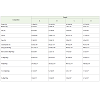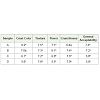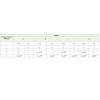Research Article
Chemical, Sensory and MicrobiologicalProperties of Cookies Produced From Maize, African Yam Bean and Plantain Composite Flour
Yusufu PA*, Netala J, Opega JL
Department of Food, Nutrition and Home Sciences, Faculty of Agriculture, Kogi State University, Anyigba, Nigeria
Corresponding author: PA Yusufu, Department of Food, Nutrition and Home Sciences, Faculty of Agriculture, Kogi State University, Anyigba, Nigeria, Phone number: 07061024372; E-mail: awodipeter2013@gmail.com
Citation: Yusufu PA, Netala J, Opega JL. Chemical, Sensory and Microbiological Properties of Cookies Produced From Maize, African Yam Bean andPlantain Composite Flour. Indian J Nutri. 2016;3(1): 122.
Copyright © 2016 Yusufu PA, et al. This is an open access article distributed under the Creative Commons Attribution License, which permits unrestricted use, distribution, and reproduction in any medium, provided the original work is properly cited.
Indian Journal of Nutrition | ISSN: 2395-2326 | Volume: 3, Issue: 1
Submission: 01/05/2016; Accepted: 15/05/2016; Published: 23/05/2016
Abstract
Chemical, sensory and microbiological properties of cookies produced from maize (Zea mays), African yam bean (Sphenostylis stenocarpa) and plantain (Musa paradisiaca) composite flours were studied. Cookies comprising different compositions of African yam bean (AYB), maize and plantain flours were prepared and coded samples B, C and D while cookie from 100% wheat (sample A) served as control. Cookies were subjected to chemical, sensory and microbial evaluation using standard methods of analyses. Cookies made from composite blends had higher levels of proteins, fat, moisture, Beta-carotene (pro-vitamin A), vitamin C and Iron. Carbohydrate level of the control sample (100% wheat) was higher than the cookies made from composite flour. There was no significant (p≥0.05) difference in the energy values of all the samples. Cookies produced from 70% maize, 20% AYB and 10% plantain composite flour had the highest score for general acceptability and compared favourable with the control cookie for almost all sensory parameters examined. Microbiological analysis (total viable count and fungal count) indicated that all the cookies prepared were free of microorganisms for up to two months of storage under ambient conditions. This study revealed that maize, African yam bean and plantain composite flour could be used in the production of nutritious and microbiologicalshelf-stable biscuits.
Keywords: Chemical; Sensory Properties; Microbiological; Cookies; Composite Flour
Introduction
Cookies are popular foodstuff consumed by a wide range ofpopulations due to their varied taste, long shelf-life and relativelylow cost [1]. Cookies are consumed extensively in Nigeria as a snack,ready-to-eat and convenient food. Cookies are majorly processedfrom wheat flour. Like most cereal-based foods. Cookies are goodsources of carbohydrates but low in proteins and vitamin A, a majormicronutrient problem among children [2]. Attempts are beingmade to improve the nutritive value and sensory qualities of cookiesby modifying their nutritive composition. This involves promotingthe use of non-wheat flour or composite flour in which locally growncrops with high protein value replaces wheat flour thereby overcomingthe challenge of continuous dependence on wheat importation which could lead to food insecurity. African yam bean (Sphenostylisstenocarpa) is a nutrient dense, but highly underutilized legumethat is predominantly cultivated in Nigeria. African yam bean seedcontains 21-29% protein; it is a good source of fibre, carbohydratesand rich in minerals [3].
Maize (Zea mays) also referred to as corn, belongs to the familygramineae and is the third most important cereal crop in the world,next to rice and wheat, with regards to cultivation areas and totalproduction [4]. Maize is a high carbohydrate food with 68% starch,10.5% protein, 5.4% fat and minerals. The corn flour can be used toprepare various food products.
Plantains (Musa paradisiaca) are potent sources of micronutrients especially pro-vitamin A, vitamin C, potassium and fibre [5]. Over 23million metric tons of plantains are produced in Nigeria annually.However, the utilization of this popular plant fruits is still limitedto the traditionally steamed, boiled or fried and roasted plantain[6]. Adeniyi et al. reported that firm ripe plantains are good sourcesof vitamins and minerals in addition to being low in fat [7]. USDAreported that plantains provide a better source of vitamin A thanmost staples. Plantains are low sodium food recommended for lowsodium diets [4].
From literature review, there is scanty information about anyattempt to produce cookies from African yam bean, maize andplantain composite flour. This study is therefore aimed at evaluatingthe chemical sensory and microbiological properties of cookiesproduced from African yam bean, maize and plantain compositeflour.
Materials and Methods
Sources of Raw Materials
African yam bean (AYB) seeds, maize grains and firm ripeplantain were obtained from Anyigba Central Market, Kogi State,Nigeria.
Preparation of African Yam Bean (AYB) Flour
AYB flour was prepared following the method derscribed byYusufu, et al. [5]. AYB seeds were cleaned of dirts, parboiled (100 °Cfor 20 min) in an aluminum pot with lid. The parboiled seeds weredrained for 5 minutes, dehulled manually and washed with cleanwater. The seeds were oven dried and toasted at 150 °C for 1 hr. Thetoasted seeds were milled in a hammer mill and sieved through a500μm mesh. The flour was packaged in an air tight container.
Preparation of Maize Flour
Maize flour was processed using the method described by Enwere[3]. The grains were cleaned and washed. The cleaned grains wereboiled in water at 100 °C for 10 minutes and drained for 10 minutes.The grains were dried in an oven (uniscope 9053) at 70 °C for 1 hr andthe dried grains were dehulled by the use of hands and winnowed.The dehulled grains were milled and sieved (500μm) and packaged.
Preparation of Plantain Flour
The method described by Enwere was used to prepare theplantain flour [3]. Firm ripe plantain fruits were washed to removeadhering soil particles, peeled and sliced into thin thickness of about2mm. 5.25ml of 2.0% sodium metabisulphite was added to each 500gweighed chopped pulp and allowed to stand for 20 min and driedin the cabinet dryer at 50 °C for 24hr. The dried plantain slices weremilled into flour using a hammer mill and sieved through 500μmsieve. The flour was packaged and sealed in polyethylene bag.
Blend Formulation
Maize, AYB and plantain flour were blended in a proportion of70: 20: 10 (maize: AYB: Plantain) and coded sample B, 60: 20: 20 toproduce sample C and 50: 25: 25 to produce sample D. Cookies madefrom 100% wheat was coded sample A and served as control.
Proportions of Ingredients
The proportions of ingredients used in cookies productionwere as described by Chinma et al. with slight modification [1]. The ingredients consist of 100g flour, 53.0g of sugar, 26.5g of margarine,1.10g of sodium bicarbonate, 0.89g of sodium chloride, 7.5ml ofunsweetened evaporated liquid milk (peak) and 12.0ml of water.
Preparation of Cookies
The flour was mixed with other ingredients and blendedthoroughly to form dough. The dough was placed on a clean table,rolled and cut out into required shapes, baked in an oven at 180 °Cfor 30 minutes. The cookies were allowed to cool and packaged in lowdensity polyethylene bags of thickness 0.5mm and stored in air tightcontainers for further analysis.
Chemical Analysis
The moisture, crude protein, fat, crude fibre and ash contents weredetermined following the procedure outlined by AOAC [8], whilecarbohydrate was calculated by difference [9]. Energy was calculatedusing Atwater factors (9x fat, 4x protein and 4x carbohydrate).Beta carotene, Vitamin C, potassium and calcium contents weredetermined following the methods described by Onwuka [9].
Sensory Evaluation
Sensory evaluation was conducted mid-afternoon (1.00-2.00p.m.) in a sensory evaluation room. A-20 member Panel was trainedon sensory attributes for the evaluation. The scores were based onthe intensity of organoleptic quality attributes of taste, crust color,flavor, texture and overall acceptability. Each sensory attribute wasrated on a-9 point Hedonic Scale (1= disliked extremely while 9=liked extremely).
Microbiological Analysis
Microbiological analyses were carried out according to the methoddescribed by Jideani [10]. One gram of sample was homogenized in10ml of 1/4 Strength Ringer’s Solution. Dilutions were made by mixing1.0ml of the homogenate in 9.0ml of the sterile diluent to obtain10-1 dilution. The dilution was then made up to 10-2, 10-3 and 10-4.Total viable counts of bacteria were determined by enumerating thecolony forming units (cfu) by pour plating on nutrient agar plates andcultured at 37 °C for 48hrs. The number of colony forming units oneach plate was counted using colony counter and expressed as cfu/g.
Total fungal counts were determined by pour plating on potatodextrose agar plates supplemented with 1.0% tartaric acid to inhibitbacterial growth and incubated at room temperature (30±2 °C) for4-6 days. The number of colonies were expressed as cfu/g. All theanalyses were carried out in triplicates.
Statistical Analysis
Data were subjected to analysis of variance as described byEgbekun and Akubor [11]. Least significance difference (LSD) testwas used to separate means where significant. Significance wasaccepted at (p≤0.05).
Results and Discussion
Chemical Composition of the Cookies
The chemical composition of cookies is shown in Table 1. Therewas significant difference (p≤0.05) between cookies made fromcontrol (100% wheat) and composite flours in terms of protein,moisture, ash and carbohydrate. A gradual decrease in carbohydratewith increasing level of AYB flour inclusion was observed while thereverse was the case with protein content. This is in agreement withYusufu et al. [12] who reported a decrease in carbohydrate contentof cookies when green bean flour was blended with wheat to producecookies. Sample D had the highest level of protein (18.71%). Thehealth benefits of proteins are well documented. The energy valueranged from 408Kcal in sample D to 417 Kcal in sample A with nosignificant ((p≥0.05) difference among the samples.
World Health Organization (WHO) recommended 1790Kcal to2500 Kcal/day of energy for children aged between 5 and 19 years[4]. This suggests that biscuits prepared from flour blends comprisingof maize, AYB and plantain could be included in school feedingprogrammes for children. Beta carotene and Vitamin C increasedsignificantly (p≤0.05) with increased level of plantain flour. Betacarotene is a pro-vitamin A. Vitamin A is a powerful natural antioxidantand required by the body for maintaining the integrity ofskin and mucus membranes. It is an essential vitamin for good visualsight. Vitamin C is vital in iron metabolism and subsequent fightagainst iron deficiency anaemia Akubor [13].
The composite cookies were higher in all the minerals (Ca, K andFe) than the control. This could be attributed to the relatively highermineral content of AYB and plantain. From the results of the mineralcomposition of cookies shown in Table 1, it is evident that cookiesprepared from the composite flour of maize, AYB and plantain aremore nutritious than 100% wheat flour cookies. This study is inagreement with the values reported by Chinma et al. for tiger nut andpigeon pear flour cookies [1].
The sensory characteristics of cookies are shown in Table 2.The statistical analysis showed that there was significant difference((p≤0.05) among the cookie samples in crust color. Control sample(A) had the highest score while sample D had the least score. Therewas no significant (p≥0.05) difference in texture. The panelistsshowed preference for sample A in terms of flavor. The inherentbeany flavor of the composite cookies may have accounted for thelower rating by the panelists. All the samples were scored high in terms of crunchiness. For the general acceptability, cookies preparedfrom 70% maize, 20% AYB and 10% plantain composite flour had thehighest score next to control sample. Sample B therefore, competedfavorably with 100% wheat cookies.
Result of microbiological analysis of the samples is shown inTable 3. No visible growth was observed on all the samples duringtwo months of storage. This is an indication that the cookies wereprepared under good hygienic condition and the integrity of thepackaging material used was not compromised. Total viable countresults showed growth on all the samples except sample A after thethird month of storage. This could result from the increased level ofproteins and fats of the sample as shown on Table 1. Adams and Mossreported that spoilage organisms grow faster in a medium that ishighly nutritious. The forth month of storage showed fungal growthon samples B, C and D [14]. The control had no visible fungal growththroughout the four months of storage. Fungal growth on foods couldlead to deposit of mycotoxins on foods which are a public healthconcern. This study has demonstrated that cookies produced fromcomposite flour of maize, AYB and plantain are microbiologicallysafe during two months of storage but could pose health risk afterthree months of storage.
Conclusion
This study has demonstrated that nutritious and acceptablecookies that are microbiologically shelf-stable could be producedfrom composite flour made from maize, AYB and plantain. The use ofsuch composite flour will reduce over dependence on imported wheatflour. Since Nigeria climate is not favourable for wheat production, alot of foreign exchange may be conserved and food security may beguaranteed if such composite flour from local crops are used.
Acknowledgement
The authors highly acknowledge the Management of KogiState University and the Department of Food, Nutrition and HomeSciences in particular for making the Laboratory available for thiswork. We are grateful.
References
- Chinma CE, James S, Imam H, Ocheme OB, Anuonye JC, et al. (2011) Physicochemical Sensory Properties and In-Vitro Digestibility of Biscuits made from Blends of Tigernut and Pigeon Pea. Nig J Nutr 32: 55-62.
- Ingbian EK, Akpapunam MA (2005) Appraisal of Traditional Technologies in the Processing and Utilization of Mumu a cereal based local food product. African J Food Agr Nutr Dev 5: 1-18.
- Enwere JN (1998) Foods of Plant Origin. Afro-Obis Publication Ltd. Nigeria.
- USDA (2009) National Nutrient Database for Standard Reference.
- Yusufu PA, Mosiko TB, Ojuko OO (2014) Effect of Firm Ripe Plantain Fruit Flour Addition on the Chemical, Sensory and Microbial Quality of Fura Powder. Nig Food J 32: 38-44.
- Kiin KD, Eke EJ (2013) Physicochemical and Sensory Properties of Cakes and Cookies Produced from Composite Flour of Wheat and Plantain. Wudpecker J Food Tech 1: 9-13.
- Adeniyi TA, Sanni LO, Barimalaa IS, Hart AD (2006) Determination of Micronutrients and Colour Variability among New Plantain and Banana Hybrids Flours. World Journal of Chemistry 1: 23-27.
- AOAC (2012) Official Methods of Analysis. Association of Official Analytical Chemists, Washington, DC.
- Onwuka GL (2005) Food Analysis and Instrumentation, Theory and Practice. Napthali Prints, Lagos, Nigeria.
- Jideani VA, Jideani IA (2006) Laboratory Manual of Food Bacteriology. Amana Publishers. Kaduna, Nigeria.
- Egbekun MK, Akubor PI (2013) Research Methods for Science Studies. Ambik Press Ltd., Nigeria.
- Yusufu MI, Obiegbuna JE, Yusufu PA (2015) Studies on the Utilization of Green bean as Raw Material in Cookies Produced from Wheat Flour. Agr Sci Research J 5: 92-97.
- Akubor PI (2011) Physiochemical, Microbiological and Sensory Properties of Yoghurt Supplemented with Carrot Juice. Nig J Nutr 32: 15-19.
- Adams MR, Moss MO (1999) Food Microbiology Royal Society of Chemistry, London.



